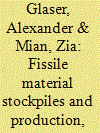| Srl | Item |
| 1 |
ID:
085059


|
|
|
|
|
| Publication |
2008.
|
| Summary/Abstract |
This article presents estimates of global and national stockpiles of highly enriched uranium and separated plutonium based on the 2008 Global Fissile Material Report by the International Panel on Fissile Materials.1 The global stockpile of highly enriched uranium (HEU) is estimated to be 1670 ± 300 tons. It is declining as Russia and the United States blend down about 40 tons per year of HEU for use in light-water power-reactor fuel. This rate of blend-down is far higher than the estimated rate of production of HEU, currently believed to be limited to production by Pakistan for weapons and by India for naval fuel. The global stockpile of separated plutonium, all of which can be used for weapons, is about 500 tons. About half of this stockpile is civilian and is currently growing at less than 5 tons a year. This rate will increase significantly once Japan's Rokkasho reprocessing plant begins commercial operation. Only India and Pakistan and perhaps Israel are believed to be producing plutonium for weapons, at a combined rate of less than 60 kg per year. The United States and Russia have declared as excess to weapons requirements or for all military purposes a significant fraction of their stocks of both highly enriched uranium and plutonium produced for weapons. The United States and Russia continue to blend down the 210 and 500 tons, respectively, of HEU that they have declared excess to produce low-enriched uranium to fuel light-water reactors. The United States and Russia have yet to put in place the infrastructure to eliminate the 34 tons of excess weapons plutonium each committed to dispose under the 2000 U.S.-Russian Plutonium Management and Disposition Agreement. The past two years have also seen plans for new civilian enrichment plants and progress on new reprocessing plants. During this time, some former production facilities have been shut down, others dismantled, and in some cases key components have been demolished.
|
|
|
|
|
|
|
|
|
|
|
|
|
|
|
|
| 2 |
ID:
143503


|
|
|
|
|
| Publication |
Doedrecht, Kluwer academic publishers, 1994.
|
| Description |
xi, 219p.hbk
|
| Standard Number |
0792331249
|
|
|
|
|
|
|
|
|
|
|
|
Copies: C:1/I:0,R:0,Q:0
Circulation
| Accession# | Call# | Current Location | Status | Policy | Location |
| 041149 | 669.2934/GAR 041149 | Main | On Shelf | General | |
|
|
|
|